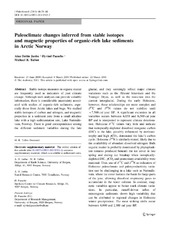Paleoclimate changes inferred from stable isotopes and magnetic properties of organic-rich lake sediments in Arctic Norway
Peer reviewed, Journal article
Published version
Permanent lenke
https://hdl.handle.net/1956/5204Utgivelsesdato
2011-03-22Metadata
Vis full innførselSamlinger
- Department of Earth Science [1050]
Sammendrag
Stable isotope measures in organic matter are frequently used as indicators of past climate change. Although such analyses can provide valuable information, there is considerable uncertainty associated with studies of organic-rich sediments, especially those from Arctic lakes and bogs. We studied stable isotopes of carbon and nitrogen, and magnetic properties in a sediment core from a small alkaline lake with a high sedimentation rate, Lake Nattma°lsvatn, Norway. There is good correspondence among the different sediment variables during the late glacial, and they seemingly reflect major climate variations such as the Allerød Interstade and the Younger Dryas, as well as the transition into the current interglacial. During the early Holocene, however, these relationships are more complex and d13C and d15N values do not stabilize until *7,500 cal year BP. A significant excursion in all variables occurs between 6,850 and 6,500 cal year BP and is interpreted to represent climate deterioration. Holocene d13C values vary little and indicate that isotopically-depleted dissolved inorganic carbon (DIC) in the lake, possibly influenced by methanotrophy and high pCO2, dominated the lake’s carbon cycle. Holocene d15N is similarly muted, likely due to the availability of abundant dissolved nitrogen. Bulk organic matter is probably dominated by phytoplankton remains produced beneath the ice cover in late spring and during ice breakup when isotopicallydepleted DIC, pCO2 and ammonium availability were maximal. Thus, use of d13C and d15N as indicators of Holocene paleoclimate and paleoproductivity variation can be challenging in a lake such as Nattma°lsvatn, where ice cover isolates the basin for large parts of the year, allowing dissolved respiratory gases to accumulate in the water column. In contrast, magnetic variables appear to better track climate variations. In particular, runoff-driven influx of minerogenic sediments shows high variability that can be attributed to regional changes in Holocene winter precipitation. The most striking shifts occur between 4,000 and 2,300 cal year BP.

